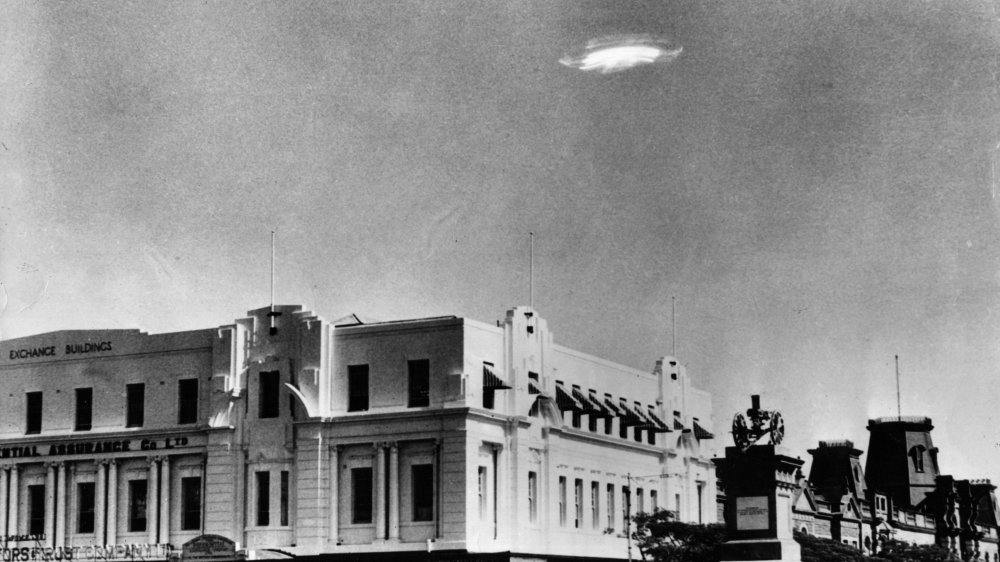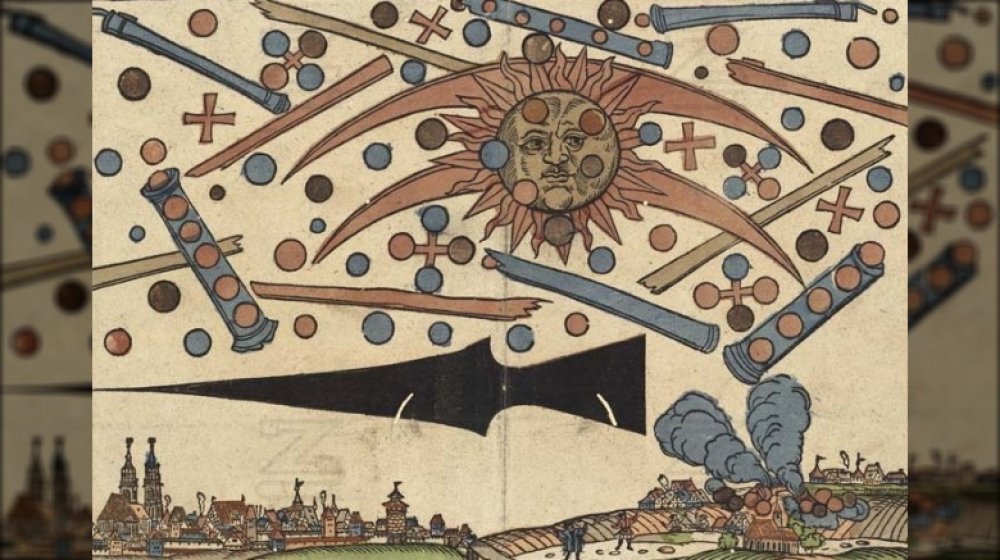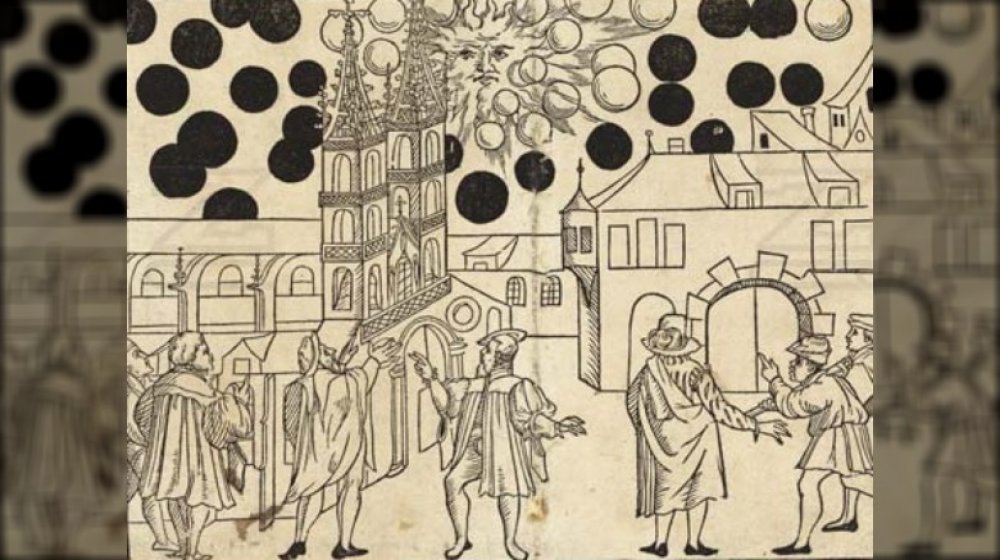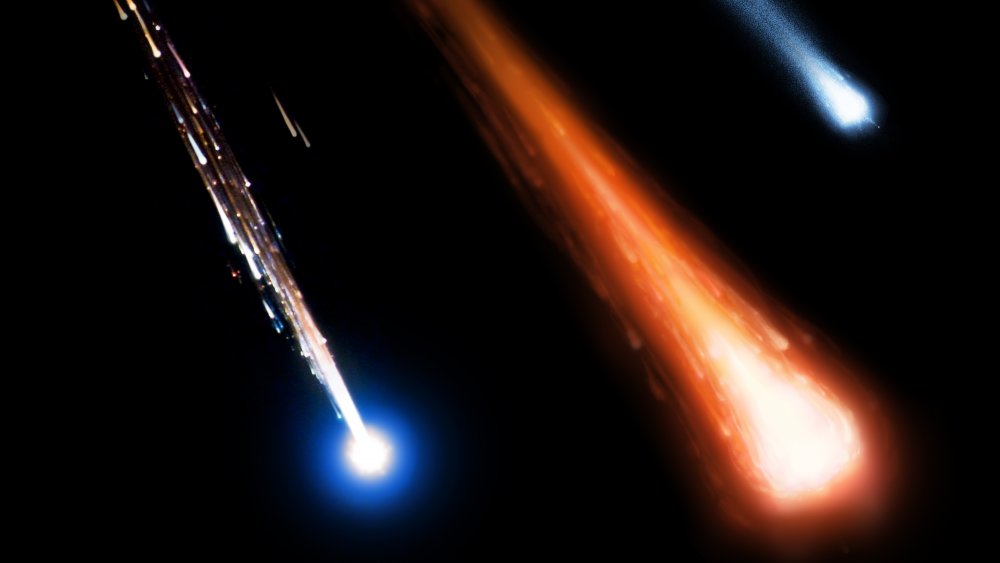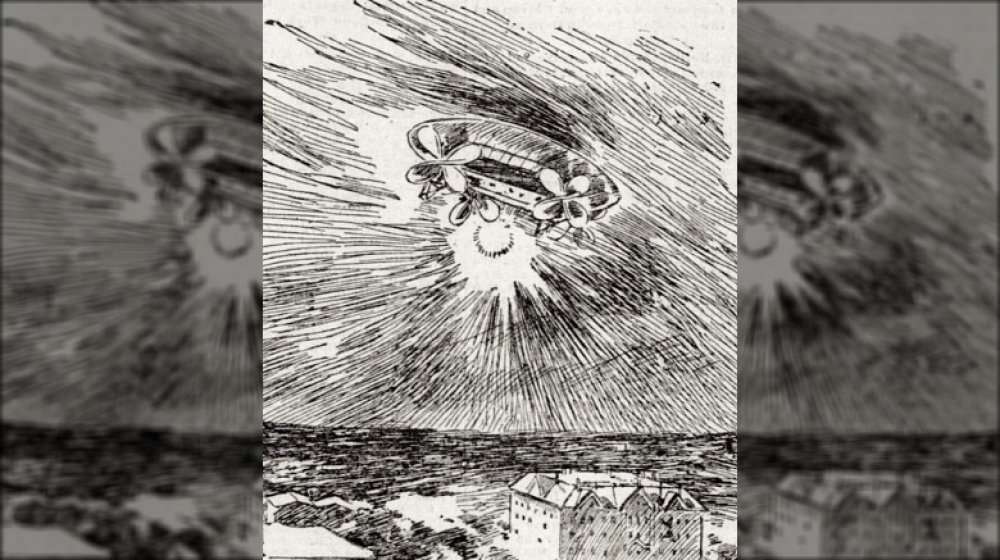The Wild True Stories Of Historical UFO Sightings
Throughout history, there have been many instances of inexplicable phenomena. People have tried to retroactively explain these events, and many believe them to be records of some of the earliest UFO sightings. While some events are now seemingly explicable and attributed to meteorological phenomena, others remain truly ambiguous in their origins. And since there are few historical records with which to compare and contrast, some of these occurrences may never be fully understood.
Despite the scarcity of primary sources, many of these oddities remain up to interpretation. While they can all be classified as unidentified flying objects, or UFOs, some of the older sightings from antiquity raise the question of poetic liberties that authors might have taken. Nevertheless, in every fiction, there is a piece of truth, which explains why ufologists have tried to document as many otherworldly instances as possible.
There have been tons of documented UFO sightings and even more undocumented sightings. The following takes a look at some repeatedly referenced incidents which have occurred around the world. These are the wild true stories of historical UFO sightings.
Fiery UFOs sighted streaking across the sky
The Tulli Papyrus was first written about in an issue of Doubt, a journal of the Fortean Society, in 1953. According to Wonders in the Sky: Unexplained Aerial Objects from Antiquity to Modern Times by Jacques Vallée and Chris Aubeck, an amateur Egyptologist named Boris de Rachewiltz had submitted a translation of an ancient Egyptian papyrus that he had received from Alberto Tulli's brother. Tulli had been the Vatican Museum director, and the Tulli Papyrus was reportedly found among his things after his death.
Supposedly from around the year 1515 BCE, the Tulli Papyrus speaks of "a circle of fire that was coming in the sky [...] They were more numerous than anything. They were shining in the sky more than the sun to the limits of the four supports of heaven." Many ufologists consider the Tulli Papyrus as one of the earliest recorded instances of a UFO, but the authenticity of the document itself is highly contested.
Not only is the location of the original papyrus unknown, but Rachewiltz apparently constructed his translation out of Tulli's notes rather than using the original papyrus. And Tulli's interaction with the papyrus itself was also limited, having made a quick transcription of its hieroglyphs during a visit to Cairo rather than actually possessing it, as he couldn't afford to buy it at that time. According to The New York Times, when researcher Dr. Edward U. Condon looked into the papyrus, he found that it was most likely a hoax.
Phantom ships in the night
In The History of Rome, Roman historian Titus Livius, also known as Livy, wrote of a spectacle in the sky among other ominous omens that befell Rome during the Second Punic War. In addition to a market that had been struck by lightning and a raven flying down into Juno's temple, Livy wrote that "phantom ships had been seen gleaming in the sky" in the winter of 218 BCE. The omen reoccurred multiple times: "At Arpi round shields were seen in the sky" in 216 BCE, and in 212 BCE, "at Reate a huge stone was seen flying about."
While seeing cloud formations as portents was common in antiquity, the 218 sighting is frequently regarded as one of the earliest descriptions of a UFO. According to one translation, "beings in human shape and clothed in white were [also] seen at a distance, but no one came close to them." Unfortunately for Livy, he wasn't actually living yet when these sightings occurred. He was born almost 150 years later, and the source of the original recorded events has been lost to history.
According to NASA, Roman thinkers at the time typically thought of such aerial phenomena as meteorological events. But it's impossible to know whether writers were offering their own descriptive interpretations of the phenomena or if they were describing these visions literally.
Was it a UFO or a spark?
Another Roman writer, Pliny the Elder, wrote of UFOs a few times. The most commonly cited sighting was in 76 BCE, when a group of people saw a spark fall from the sky, "increase in size as it approached the earth, and after becoming as large as the moon it diffused a sort of cloudy daylight, and then return[ed] to the sky." Pliny also wrote of three moons appearing at once at 122 BCE and "a burning shield scattering sparks ran across the sky at sunset from west to east" in 85 BCE.
According to the NASA Goddard Space Flight Center, the phenomenon that Pliny describes isn't particularly unique. Such descriptions of shooting sparks and balls of fire were common throughout Roman literature, but the actual cause is still contested. Theories include comets, novas, ball lightning, UFOs, and meteoric fireballs.
Despite the seemingly odd movement of the spark, it does conform to modern studies of fireballs. To a stationary observer, it would appear as though the star-like spark was growing to be as large as the moon. And after passing, its trail would appear as a vertical ascent. Despite these theories, no one knows for sure exactly what caused this falling spark.
According to Plutarch
A Greek historian named Plutarch also wrote of apparitions that occurred before his birth. Plutarch wrote that when a battle was about to begin between the forces of L. Licinius Lucullus and King Mithridates VI of Pontus, "the sky burst asunder, and a huge, flame-like body was seen to fall between the two armies. In shape, it was most like a wine-jar, and in color, like molten silver. Both sides were astonished at the sight, and separated. This marvel, as they say, occured in Phrygia, at a place called Ortyae."
One suggestion from NASA is that the flame-like object was a meteorite, though the silver color doesn't correspond with the typically black color of a meteorite. And while Phrygia has a tradition of meteorite worship, historical records about Phrygian meteorites don't mention the incident, said to have taken place in 74 BCE.
It should also be noted that by his own admission, Plutarch was more interested in moral lessons from history rather than detailing history in its actuality, noting in his biography of Alexander, "for it is not Histories that I am writing, but Lives." This opens up the possibility that the falling wine-jar object was written as a metaphor rather than a literal description. However, it's impossible to know for sure.
Unidentified flying chariots
One of the most important works by Titus Flavius Josephus was The Jewish War, which told of the Jewish revolt against Rome. Describing an event that took place in 66 CE, Josephus wrote that "before sun setting, chariots and troops of soldiers in their armour were seen running about among the clouds, and surrounding of cities," reportedly occurring on the eve of the First Jewish-Roman war. According to Ancient Origins, Josephus' account bears a striking similarity to a prophecy from the Book of Revelations, which describes Jesus' second coming to Earth with an army of angels.
There's debate among scholars as to whether or not the descriptions of chariots were an attempt by Josephus to make the Jewish people sympathetic to the Romans. There's also the suggestion that since Josephus' account was written after the Temple of Jerusalem had been destroyed, it's possible that the passage is meant as an explanation of why God let such a thing happen.
Roman historian Tacitus also wrote about the event in 115 CE, hearing of it secondhand, as did Eusebius in 325 CE. While writers and historians once thought of this event as a sign from God, many are now considering that it might have been something completely unearthly. The fact that multiple people wrote specifically about the sight of fiery chariots is taken to suggest that the image is more than just a metaphoric description.
The hair of angels or extraterrestrials?
The Roman historian Cassius Dio recorded a marvelous apparition in 196 CE. Writing in the Epitome of Book LXXVI of Roman History, he notes that the sky looked as though it was burning even during the nighttime. But what was most miraculous was the "fine rain resembling silver descended from a clear sky up the Forum of Augustus. I did not, it is true, see it as it was falling, but noticed it after it had fallen, and by means of it I plated some bronze coins with silver; they retained the same appearance for three days, but by the fourth day all the substance rubbed on them had disappeared."
In Maternal Megalomania, author Julie Langford notes that several scholars consider this scene to be an omen that Dio places himself amid, though the omen is one created out of poetic dissent rather than an otherworldly occurrence. There is a play of semantics with the Greek word for "silver," which includes "white" and is considered to be a play on Clodius Albinus' name. Since the coins only held their silver color for three days, and Albinus was emperor for three years, the counterfeit nature of the coins is meant to reflect the counterfeit nature of Albinus' rule.
However, it's unclear if Dio truly did encounter a silver rain that faded away after several days. If he didn't mean it as a metaphor, the event may be considered a close encounter of the second kind.
Anchor away!
According to the History of British Folklore by Richard Mercer Dorson, Gervase of Tilbury wrote about people witnessing a flying ship that got its anchor lodged in a church in England in 1211. Vallée and Aubeck promoted the sighting as an extraterrestrial affair in their book Wonders in the Sky, though they noted that the story comes out of multiple tellings, of which Gervase was merely a collector.
The story goes that as people were exiting a church in Bristol, a ship in the sky got its anchor caught on a pile of stones as its cable reached upward into the clouds. "Voices were then heard above the clouds, apparently in clamorous debate, and a sailor came down the cable. As soon as he touched the ground, the crowd gathered around him, and he died, like a man drowned at sea, suffocated by our damp thick atmosphere."
The cable was cut an hour later, and the ship sailed away, leaving the anchor behind, which was reportedly remade into ornaments and fastening for the church door. Some accounts even claim that the villagers stoned the man to death, rather than him dying from atmospheric suffocation. However, to this day, no one knows what happened to the "man" or which exact church was caught by the anchor.
An aerial battle or just a sundog?
A sighting in Nuremberg, Germany, definitely looks like an extraterrestrial affair at first glance. According to The Public Domain Review, the event occurred on April 14, 1561, and local artist Hans Glaser created a broadsheet describing the event in detail.
Glaser wrote, "At first there appeared in the middle of the sun two blood-red semi-circular arcs, just like the moon in its last quarter. And in the sun, above and below and on both sides, the color was blood, there stood a round ball of partly dull, partly black ferrous color." The globes went on to engage in what looked like an aerial battle until they fell extinguished from the sky. Glaser considered it a religious event, though "whatever such signs mean, God alone knows."
The occurrence became well-known in popular culture after it was mentioned in Carl Jung's 1958 book Flying Saucers. But Jung didn't necessarily think that the event was of alien origin, instead attributing it as either a natural occurrence or a political metaphor. Most theories now agree that the best explanation for the 1561 Nuremberg phenomenon was a sundog, also known as a parhelion. When parts of the atmosphere reflect the sun's light and act like a prism, it appears as though there are multiple halos and globes in the sky. But at the time, it was possibly in the interest of the printing presses to propagate stories about signs from God.
Celestial interpretations
Jung wrote of another broadsheet that told of an aerial oddity, popularizing the event now known as the 1566 celestial phenomenon in Basel. The broadsheet of 1566 is similar to the one from 1561, showing dozens of black and white globes in the air, seemingly coming out of the sun. But unlike the incident in 1561, these aerial phenomena were seen across three separate days.
According to Inquisitive Wonder, on July 27, 1566, residents of Basel, Switzerland, watched as the sun shrunk, the sky grey dark, and the moon turned blood red. The next day, the sun maintained its appearance, and everything in the city had a red hue. By evening, things seemed to have returned to normal, but on August 7, the citizens saw black globes flying about in front of the sun at extraordinary speeds. Some globes were colored red, but they all seemed to crumble into nothing.
At the time, people considered it a fight between Heaven and Hell. In The Philosophy of UFOs, author Gerald Roski suggests that the phenomenon could have been caused by a burst from the impending B Cassiopeiae supernova of 1572, though then there would've been increased instances and accounts of celestial activity and presumably more broadsheets at the time of the supernova. Like the celestial phenomenon of 1561, it could also have been a tool of church propaganda. But ultimately, the Basel sighting of 1566 remains shrouded in ambiguity, left up to interpretation.
Reappearing balls of fire
This may be the earliest known UFO sighting from Russia, though it certainly wasn't the last. In 1663, the town of Robozero witnessed a "ball of fire" so spectacular that the Saint Cyril monastery sent a formal report about it. In Cosmological Ice Ages, author Henry Kroll claims that the authenticity of this account is unquestionable.
According to Ivachko Rievskoi, who penned the formal report, "at noon, a large ball of fire came down over Robozero, arriving from the clearest part of the cloudless heavens. It came from the direction whence winter comes, and it moved towards midday along the lake passing over water surface." It's said to have disappeared, only to return again less than an hour later, an act that it would repeat several times. The ball was also said to have made the water hot and rust-colored, while men in boats could feel the heat from the fiery object.
Other than Rievskoi's account, there are no other records to confirm this occurrence. But if Rievskoi's report is to be considered accurate, it's unclear whether this event could have been a meteor or something else.
The woman from the hollow UFO
While there are many reports from Japanese oral tradition about "hollow ships" during the Edo period, an incident from 1803 is possibly the most well-recorded. According to The AV Club, in 1803, an utsuro-bune, which translates to "hollow ship," washed ashore on Japan's eastern coast in the province of Hitachi. Inside the craft was a woman who didn't speak Japanese. Descriptions of her clothing as well as the size and shape of the vessel vary depending on the report.
It's possible that the story is a retelling of an earlier folktale, being an iteration of a legend from the Kawano dynasty about finding a young girl adrift at sea. But researcher Tanaka Kazuo has been able to find at least 11 different documents that tell of the woman and her utsuro-bune, all of which appear to be from 1803.
The Hitachi utsuro-bune incident was also illustrated a number of times, with many calligraphers depicting the mysterious vessel and its captain. It's this consistency that makes researchers like Tanaka Kazuo think that the 1803 incident is more than just an iteration of a folk legend. Some even drew the utsuro-bune as having mysterious markings on the inside, which Tanaka admits might be decorative but doesn't deny the possibility that it may one day be discovered to be an alien script. But for now, it's up for speculation.
The ambiguous airship waves
From 1896 to 1897, countless people were said to have seen airships starting in the west and moving eastward across the United States. According to Free Energy Pioneer by Theo Paijmans, while there may have been scattered sightings earlier, most agree that the airship waves started on the night of November 17, 1896. Over the city of Sacramento, California, hundreds of people saw what looked like a giant balloon with a bright electrical light coming off of it.
Over the next few days, more and more people across California reported seeing airships in the sky, and into December, there were sightings across Nevada, Arizona, Oregon, and Washington. Due to press sensationalism perpetuating the sightings, it's difficult to know the reliability of the reports. According to The Guardian, the wave of airships was most likely a hoax, since the first successful dirigible flight didn't occur until 1900.
Since yellow journalism played a prominent role in propagating the idea of these mysterious airships, it's possible that a feedback loop was created between actual celestial phenomena and sensationalized reporting, and most people may have seen something happening in the sky that was then regurgitated into a "massive airship" by the press. But due to the inability to confirm any of the reporting, the mysterious airship waves remain an ambiguous occurrence of history.
